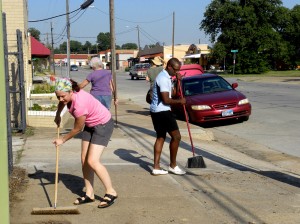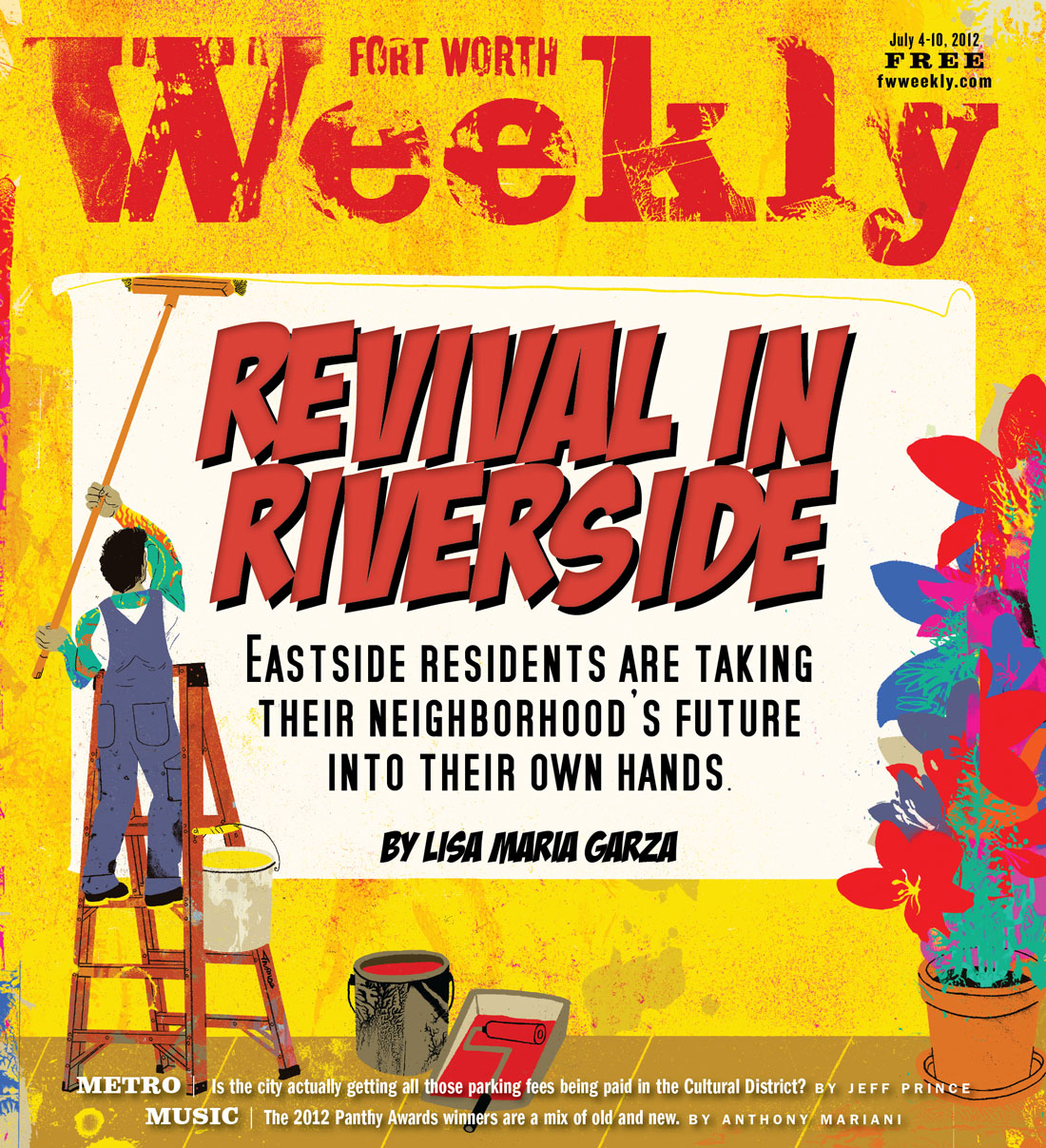The line to order lunch at Fuzzy’s Taco Shop on Race Street was 20 minutes long on a recent Friday. Shelby Stevens didn’t mind. A line of customers indicates a healthy business climate, and the businesses on this Eastside street have had their share of struggles. It wasn’t that long ago that Stevens would waltz into Fuzzy’s during a typical rush hour, order within seconds, and have the room to himself.
“I’ve always liked this area,” he said. “It’s got so much potential. Oakhurst, Race Street, Six Points — you could do so much with this area.”
Stevens mentioned the vacant lofts next door and the numerous empty retail spaces scattered along the street. He loves the food at Mamma Mia Italian Grill & Pizza at the Race Street gateway, but said he seldom sees a crowded dining room. Private developers will have to work closely with city staff to pump new life into the area, he said. But growth depends on locals, and the neighborhood has traditionally been, well, sleepy.
“It’s always been quiet after dark around here,” he said, speaking with the authority of someone who has lived in the neighborhood for most of his 56 years.
“It may be that the community likes it that way.”
Race Street’s renovation began with fanfare in the mid-2000s. The dreary street was brought back to life with a banquet hall, various shops, and popular eateries such as Fuzzy’s. Fort Worth Weekly wrote about the efforts six years ago (“Bright Lights, Big Fights,” April 5, 2006). “Bright lights” referred to developers turning Race Street into a vibrant place to do business, eat lunch, unwind at happy hour, listen to music, cop a tattoo, and view the works of local artists.
“Big fights” referred to the smattering of residents in the surrounding area who didn’t want to see their quiet neighborhood invaded by anything remotely similar to Dallas’ Deep Ellum or Fort Worth’s West 7th Street corridor.
Hurdles remain. The economy is still wheezing. Banks aren’t handing out loans like lollipops. Some of the original developers have sold out or gone bust. And city officials aren’t yet turning loose of nearly $740,000 set aside to pay for streetscape improvements. But a new wave of developers and business owners is attacking those hurdles, and they remain confident that Race Street is on track to become an arts district reminiscent of Magnolia Avenue’s funky but family-friendly vibe.
********

Justin McWilliams came along just after the millennium with a vision of breathing new life into Race Street as an entertainment mecca. But the Riverside neighborhood had spent years trying to clean up squalid bars and rundown apartments, and some residents weren’t eager to embrace more bars or even fancy chain restaurants if it meant more noise and drinkers. City planners, neighborhood associations, and volunteers had hammered out an urban development plan that called for improved streetscapes, farmers markets, and family-friendly strolling and shopping.
“Justin made a lot of changes, some of which people liked and some they didn’t like, but at least he was trying to do something positive,” said lifelong Riverside resident and historian Rick Herring. “We can thank him for bringing Fuzzy’s in. He aggressively sought them out. This was just Fuzzy’s second location. He talked them into coming, and it was a great thing for the neighborhood and still is.”
McWilliams could not be reached for comment, but his activity on Race Street has decreased.
“He got so much opposition from neighborhood groups, he got tired of fighting,” Herring said.
McWilliams made a difference before he bailed. Most of his development plans fell through, but he hit a home run with Fuzzy’s and brought widespread attention to the street that had been overlooked for years. A veil that seemed to obscure Riverside’s charms and make the area invisible to developers for so long had finally been lifted.
Developers are accustomed to dealing with opposition, but the deep recession that took root in early 2008 was an even tougher adversary.
Jason Miller, who was also developing several properties on Race, got an offer to sell his portfolio in 2007. He had high hopes for Race Street and wanted to be involved in the revitalization. He was particularly proud of converting the historic McAdams Building into Mamma Mia’s.
“I was sold on what was going to happen over there and didn’t want to sell my properties,” he said.
But the offer was too good. So he sold to another developer with big plans. And then the crash hit.
“That all fell by the wayside,” said Miller, who now works as a landman for a natural gas drilling company in Denver. “I sold out at the right time, and [redevelopment] just sort of fizzled from there.”
Robert Holt bought a 1940s house at 2813 Race St. in 2005, converted it into a sandwich shop, and ran Emi G’s for two years. He tried to focus on a nighttime crowd, with no luck. He moved the sandwich operation to one of his other businesses, Finn MacCool’s Pub on the Near South Side, and tried to lease out his Race Street property. The recession killed that plan.
“The banks weren’t loaning anything,” he said. “No lines of credit.”
Without financing, potential business owners were stranded. Holt’s brightly painted property on Race remains vacant.
********
Some of the first dirt roads in Riverside were built in the late 1800s in an area that would come to be known locally as Six Points — where Riverside Drive intersects with Belknap and Race streets. Riverside was roughly bordered by what is now 28th Street on the north, Haltom City on the east, the railroads tracks on the south, and the Trinity River on the west.
“One of the reasons Riverside became a burgeoning neighborhood was that a bridge was put across the Trinity in the early 1900s,” said longtime Riverside resident and historian Doyle Willis Jr. “Six Points was the center of economic activity in Riverside for many years.”
A streetcar ran from downtown to Six Points. The post-World War II boom years prompted even more commercial and residential growth along Race between Six Points and Sylvania Avenue.
“Race was transformed into a business district,” said Herring, who is writing a book about Riverside’s history.
By the 1980s, however, the street was in decline. White flight was drawing middle-income families from central-city neighborhoods to the suburbs. Parts of the area changed from majority Anglo to majority Hispanic between 1990 and 2000. Riverside’s aging homes attracted families with lower incomes. Once-shiny apartments became run-down over time. And Race Street lost its footing.
“The movie theaters closed,” Herring said. “The post office and bank both moved a couple of blocks away. By the early ’90s it was fairly seedy.”
A printing shop, record store, and an attorney’s office remained, but the main attraction became the half-dozen small bars that opened near Race and Sylvania.
“They were really trouble spots,” Herring said. “After dark you wouldn’t want to be walking down the street.” The neighborhood partnered with the city and the Texas Alcoholic Beverage Commission to close down the most problematic bars, and none of them remain today.
********













As long as there are gang bangers, people raising bait dogs for their dog fights, guns being blasted at all hours of the night, a total garbage school district, neighbors who could care less, people afraid or too stupid to call the police, high school kids yelling racial slurs and getting beat up in daylight, a culture of ignorance, poverty, lack of any sort of community even with next door neighbors, slum lords, elderly hold outs delusional about the quality of this neighborhood in respects to property value, neighbors respects for their own property and others, stupid neighbors disregards for city laws and codes, etc . . . this neighborhood will always be what it is: Oakhurst surrounded by crap.
Well, geez! Why don’t you just leave if it is too “crazy” for you and and the rest of us will just wait for Debby Stein to gentrify the neighborhood. Revitilizing this area by reinvesting in it will raise the property taxes enough to move all these elements out eventually so just be patient and praise the artistic elements moving in. We can just throw a block party for the artists to peek thier interests and charge them exorbitant amounts to be here and it will work great for eveyone! The artists are the first wave, the shock troops if you will, to move in and bring their mind sets of how things ought to be. They will demand more police actions and other city services and then property taxes will increase and rent on residential and commercial properties will as well so the property owners in the area will benefit the most. So, if you can just wait and snatch up as much property as you can in the area OUR UTOPIA will happen! Be patient!